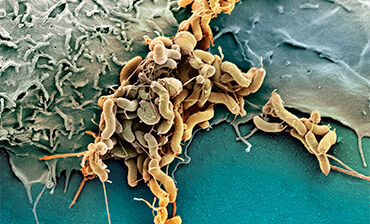Campylobacteriosis

Campylobacteriosis is a bacterial diarrhoeal disease caused by Campylobacter species, found in animals such as poultry, cattle, pigs, wild birds and wild mammals.
The most frequent way of getting infected is through the consumption of contaminated food (mainly poultry) or water. Other risk factors include swimming in natural surface-waters and direct contact with infected animals.
After an incubation period of 2–5 days (range 1–10 days) common symptoms are severe abdominal pain, watery and/or bloody diarrhoea and fever. Usually, gastrointestinal symptoms are self-limiting but occasionally they will persist and result in hospitalisation. Antimicrobial therapy is seldom needed.
Campylobacter infection has been associated with complications such as later joint inflammation (5–10% of cases) and, on rare occasions, post-infectious neurological complications such as Guillain-Barré syndrome (a temporary but severe paralysis that may be total) may occur. As a prophylactic measure, control of Campylobacter colonisation in poultry is important, as well as hygienic processing of meat, and the protection and control of private drinking water supplies.



